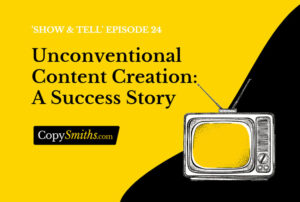Home » Content Marketing » How to Determine the Total ROI of Your Content Marketing

How to Determine the Total ROI of Your Content Marketing
Marketing. It’s the cool, new thing everyone is doing to boost their businesses. Company owners have quickly caught on to the fact that building brand awareness through effective content marketing strategies can contribute to their business value.
However, many of them still don’t know how to properly measure the return on investment (ROI).
It’s important for business owners to develop a proper content marketing program and follow through with it before moving on to analyzing the gathered information and calculating their marketing ROI.
What is Content Marketing ROI?
Content marketing ROI (return on investment) is simply described as the percentage of your investment in content marketing compared to what you spend.
The ROI formula is pretty easy to remember:
Return on Investment =[(Revenue – Investment) ∕Investment]* 100%
Sounds simple so far, right? We’ll get a more in-depth look into the factors involved later. Meanwhile, here’s a link that might help you with the basics:
Know Your Content Marketing Metrics
Before we calculate content marketing ROI, it’s important to remember that it’s completely dependent on the data you gather from the various marketing channels available at your disposal and your business goals.
You can run marketing campaigns and measure your content marketing efforts with metrics to calculate ROI.
This table shows the metrics you can use to associate with specific business goals:
| Brand Awareness | Website traffic, page, video and document views, downloads, referral links, social chatter |
| Engagement | Blog comments, likes, shares, forwards, inbound links |
| Lead generation | Form completion and downloads, email subscriptions, blog subscriptions, conversion rates |
| Sales | Online and offline sales, manual reporting, and anecdotes |
| Customer retention/Loyalty | Percentage of content consumed by existing customers, retention/renewal rates |
| Upsell/Cross-sell | Sales for new products/services |
Now, that being said, there are at the very least 70 marketing metrics that can help you achieve the insight you’re looking for, depending on the goal of the advertising campaign.
Do you need to remember all of them? No. (Wouldn’t it be impressive if you did, though?)
You can skip remembering all 70 metrics and go for the more important ones.
Here’s a few that marketers prefer over the others:
- Qualified leads
- SEO Success
- Web Traffic
- Onsite Engagement
- Social Media ROI
- Conversion Rate
- Customer Acquisition Cost
Each metric chosen can give different results based on what they represent individually or combined with others.
Some of them on their own are just vanity metrics, like web traffic or page views. They become more useful as you pair them with other metrics like time spent on page or scroll depth. You may also need to sift through paid and organic traffic.
Pro-Tip: Google Analytics is a handy tool to track metrics and provide insights.
How to Measure the ROI of Content Marketing?
This is the part where content marketers and analysts struggle the most.
Remember the simple formula we were talking about? It’s not so simple if you break it down and calculate each of the variables to determine the content marketing investment.
Let’s walk through the steps:
- Production costs: Making the content has costs attached to it. Whether it’s outsourced work or produced in-house, content creators have to be paid.
- Advertising costs: This is the next crucial expense. Proper content promotion results in excellent results. It can include paid promotions and social and sponsored advertisements.
- Sales conversions: To measure this, you’ll need to take a look at the number of leads being converted to sales. You can find out the total amount of sales made from a particular content using your analytics services (Facebook analytics, Google analytics, etc.)
- Calculate ROI: Remember the formula we already discussed? Let’s go over an example now to see how it’s used:
If you spend $200 on content creation and your lead generation ends up being worth $1000, then according to the formula,
ROI = [(1000-200)/200]* 100% = (800/200)*100 = 400%
Seeing as you earned more (made more sales) than you spent on content production, this seems to have been a successful campaign. The Revenue to Cost ratio is 4:1.
What Is a Revenue to Cost Ratio?
The ratio refers to how much money is generated per dollar invested in a marketing campaign.
Like in the example above, the ratio is 4:1, meaning 4 dollars was made for every dollar spent. A 5:1 ratio is considered an excellent result for businesses.
For obvious reasons, the higher the revenue, the better the ratio gets. Worst case scenario to best, range from 2:1 (breaking even) to 10:1 (rare, but great results).
What Else to Consider When Measuring ROI?
One of the other factors that would be important in measuring ROI would be tracking lifetime customer value. Tracking customer journeys from the first click to the first transaction isn’t enough.
The lifetime value of a customer is more precious and needs to be tracked every time they visit, even if it is through different channels.
In which case, the lifetime customer value would contribute to the increased sales metric.
Another effective content marketing strategy, although time-consuming, is converting the blog readers on your site to customers. B2B companies can gain over 68% leads through blogging alone.
The content needs to strike a chord with your target audience, compelling them to engage with it. Regular blogging also keeps your readers updated and engaged. This will help advance your goal of building your brand authority. This will, in turn, contribute to the ROI.
Just a quick reminder: All of this is also heavily dependent on content effectiveness.
Content Marketing Success: How a Good Content Writing Agency Can Help
You must amp up your marketing strategy for better results. This is why you’ll need quality content in your arsenal for your content marketing success.
Your energy would be better spent focusing on making sure your marketing campaign reaches your target audience. Here’s where it can get a little challenging to handle.
Depending on just in-house content creators for all different kinds of content needs would not be wise.
There are so many different kinds of content that it gets tough for them to be able to produce all of it and maintain quality.
The solution to this problem is simple. Outsource content. It happens all the time in the world of B2B marketing. 47% of these marketers outsource their content writing services.
As for choosing a great content writing service, you need to pick what to outsource first.
Our honest suggestion would be to outsource blogs. We’ve already established blogging to be an important strategy for lead conversion.
Here’s why:
- It’s time-consuming to produce. An informative blog is easily somewhere from 700–2000 words long.
- There needs to be a continuous stream of articles to keep the readers engaged.
- Articles have to be SEO-optimized. A well-written blog with proper SEO optimization includes inbound and outbound links and keywords that can boost your rankings in organic search of search engines like Google.
CopySmiths
I'm Katrina McKinnon, founder of CopySmiths and Small Revolution. In my 20 years of experience, I have helped online businesses create high-performing content specifically on an eCommerce store's blog. Find me on LinkedIn and Twitter.

CopySmiths offers the best blog writing services for online stores.
If you'd like us to write blog articles for you, click here.
Most Recent
- 3 Bold Questions You Should Ask When Hiring A Content Writer

- 5 Practical Reasons You Should Use a Blog Post Template

- 4 Amazing Benefits of Using a Title Generator for New eCommerce Blogs

- 10 Awesome Bio Examples Your Online Store Blog Should Emulate

- 8 Basic Steps to Successful Content Development Every Time

Podcasts
Got a question?
Ask our friendly team about our article writing services.
Subscribe to CopyZine
Monthly, hand-picked stories of the best in eCommerce Content.




